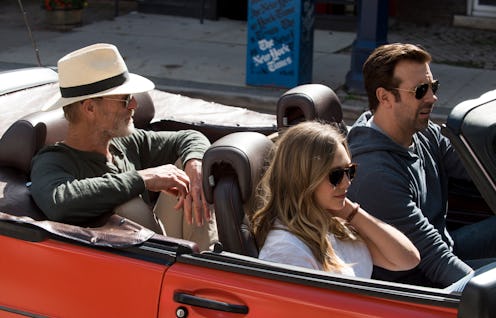Entertainment
Netflix’s New Movie Full Of Your Fave Actors Was Legit Ripped From The Headlines

Another day, another Netflix original movie. The streaming giant continues to increase its output of new and original films, and they seem to only be getting more impressive as time goes on. One of their latest is Kodachrome, a star-studded drama that's already drawing rave reviews. The film stars Ed Harris as a dying photographer whose estranged son, played by Jason Sudeikis, and his caretaker (Elizabeth Olsen) take him on a road trip to develop some film at the country's last processor of Koachrome film in Kansas before it stops providing the service for good. The film is certainly heartfelt, but is Kodachrome on Netflix a true story?
It's not a a true story, but it is an example of art imitating life. The movie was written by Jonathan Tropper, and he based it on a 2010 New York Times article by A.G. Sulzberger, according to the Associated Press (via the New York Daily News). The article in question details the stoppage of Kodachrome processing at Dwayne's Photo in Parsons, Kansas (the same store depicted in the film), which was the last processor of Kodachrome film in the world. The Times article describes how, when word got out about the store shutting down its Kodachrome business, people made pilgrimages from far and wide — including from every continent but Antarctica — to develop their old Kodachrome film before it was too late. There's obviously a lot of passion out there for Kodachrome, but what exactly is Kodachrome?
Kodachrome was one of the first types of color film, and was introduced by Kodak in 1935. The film was used for both still photographs and for films, and was widely used by professionals and amateurs alike for decades. But due to its complicated development process, Kodachrome eventually began to lose market share to new films that were easier to develop, and before long all film would largely be replaced due to the rise of digital photography, according to Kodak. Kodak announced in 2009 that it was discontinuing Kodachrome, and the last roll was processed at Dwayne's Photo in 2010. That roll belonged to noted photographer Steve McCurry, who had asked Kodak for the last roll off the assembly line, according to his YouTube channel. McCurry is perhaps best known for his work with National Geographic, especially his 1984 "Afghan Girl" photo, which was shot on Kodachrome.
During its decades of dominance, Kodachrome managed to gain a foothold in American culture even outside of the photography community. One of musician Paul Simon's most recognized tracks is "Kodachrome," which was the lead single off of his 1973 album There Goes Rhymin' Simon. The song peaked at number 2 on the Billboard Hot 100 in the year of its release, tying it for the second highest charting song in Simon's solo career, according to Billboard. Kodachrome is also, somewhat remarkably, the name of a state park in Utah. The area was first named for the film in 1948 by members of a National Geographic expedition, who took photographs of the landscape using Kodachrome, according to the park's website. The area, then known as Kodachrome Flat, was established as a state park in 1962 and soon after became known officially as Kodachrome Basin State Park — the name it still goes by today.
Kodachrome may invent its story of father-son drama, but the film's backdrop of people going on a pilgrimage to Dwayne's Photo in Parsons, Kansas to develop some Kodachrome film before the process is eliminated forever is very much based in reality. And who knows? Out of the hundreds of people who descended on Dwayne's Photo in 2010, there could very well have been some pilgrims among them whose story closely resembled the one seen on screen.